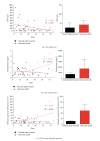Importance of follow-up cerebrospinal fluid analysis in cryptococcal meningoencephalitis
- PMID: 25374433
- PMCID: PMC4211327
- DOI: 10.1155/2014/162576
Importance of follow-up cerebrospinal fluid analysis in cryptococcal meningoencephalitis
Abstract
Cryptococcal meningoencephalitis represents a serious infection of the central nervous system, where reliable prognostic factors during the disease course are needed. Twenty-one patients diagnosed with cryptococcal meningoencephalitis in a German university hospital from 1999 to 2013 were analysed retrospectively. CSF parameters were analysed prior to therapy and during antifungal treatment and were compared between patients who survived or deceased. Fifteen patients clinically improved after antifungal therapy, while six patients died. No differences were observed between the outcome groups for the CSF parameters cell count, lactate, total protein, and CSF-serum albumin quotients (QAlb). Follow-up examinations of serum cryptococcal antigen titer and CSF cell count have shown that these parameters cannot be used to monitor the efficacy of antifungal therapy as well. In contrast, the course of QAlb during therapy was indicative for the outcome as a possible prognostic marker. In patients with clinical improvement QAlb values were falling under therapy, while rising QAlb values were found in patients with fatal outcome indicating a continuing dysfunction of the blood-CSF barrier. In conclusion, our results indicate that, among the various CSF parameters, the course of QAlb presents a promising marker that might be used to monitor the efficacy of antifungal therapy.
Figures


Similar articles
-
Measurement of antifungal drug levels in cerebrospinal fluid for cryptococcal meningoencephalitis.J Infect Chemother. 2012 Oct;18(5):775-9. doi: 10.1007/s10156-012-0368-9. Epub 2012 Feb 10. J Infect Chemother. 2012. PMID: 22318291
-
Prediction of hospital discharge outcome from changes in cerebrospinal fluid/serum albumin quotient and cerebrospinal fluid lactate dehydrogenase in patients with cryptococcal meningitis.Future Microbiol. 2022 Mar;17:223-233. doi: 10.2217/fmb-2021-0272. Epub 2021 Dec 15. Future Microbiol. 2022. PMID: 34905957
-
[Cryptococcal meningitis in children: description of 3 cases].Med Trop (Mars). 2011 Apr;71(2):176-8. Med Trop (Mars). 2011. PMID: 21695878 French.
-
Acute meningoencephalitis due to Brucella: case report and review of neurobrucellosis in children.Turk J Pediatr. 2010 Jul-Aug;52(4):426-9. Turk J Pediatr. 2010. PMID: 21043393 Review.
-
[Anthrax meningoencephalitis: a case report and review of Turkish literature].Mikrobiyol Bul. 2009 Oct;43(4):671-6. Mikrobiyol Bul. 2009. PMID: 20084923 Review. Turkish.
Cited by
-
Leptomeningeal Metastasis: The Role of Cerebrospinal Fluid Diagnostics.Front Neurol. 2019 Aug 20;10:839. doi: 10.3389/fneur.2019.00839. eCollection 2019. Front Neurol. 2019. PMID: 31481919 Free PMC article.
-
The utility of cerebrospinal fluid white cell count during the prognostic assessment for cryptococcal meningitis patients: a retrospective study.BMC Infect Dis. 2020 Aug 5;20(1):571. doi: 10.1186/s12879-020-05287-x. BMC Infect Dis. 2020. PMID: 32758162 Free PMC article.
-
Heterogeneity of clinical features and corresponding antibodies in seven patients with anti-NMDA receptor encephalitis.Exp Ther Med. 2015 Oct;10(4):1283-1292. doi: 10.3892/etm.2015.2689. Epub 2015 Aug 19. Exp Ther Med. 2015. PMID: 26622479 Free PMC article.
-
Biology and function of exo-polysaccharides from human fungal pathogens.Curr Clin Microbiol Rep. 2020 Mar;7(1):1-11. doi: 10.1007/s40588-020-00137-5. Epub 2020 Jan 17. Curr Clin Microbiol Rep. 2020. PMID: 33042730 Free PMC article.
-
The Influence of Blood Contamination on Cerebrospinal Fluid Diagnostics.Front Neurol. 2019 Jun 12;10:584. doi: 10.3389/fneur.2019.00584. eCollection 2019. Front Neurol. 2019. PMID: 31249547 Free PMC article.
References
-
- Pukkila-Worley R, Mylonakis E. Epidemiology and management of cryptococcal meningitis: developments and challenges. Expert Opinion on Pharmacotherapy. 2008;9(4):551–560. - PubMed
-
- Zuger A, Louie E, Holzman RS, Simberkoff MS, Rahal JJ. Cryptococcal disease in patients with the acquired immunodeficiency syndrome. Diagnostic features and outcome of treatment. Annals of Internal Medicine. 1986;104(2):234–240. - PubMed
-
- Currie BP, Casadevall A. Estimation of the prevalence of cryptococcal infection among patients infected with the human immunodeficiency virus in New York City. Clinical Infectious Diseases. 1994;19(6):1029–1033. - PubMed
-
- Dromer F, Mathoulin-Pélissier S, Fontanet A, Ronin O, Dupont B, Lortholary O. Epidemiology of HIV-associated cryptococcosis in France (1985–2001): comparison of the pre- and post-HAART eras. AIDS. 2004;18(3):555–562. - PubMed
-
- Robinson PA, Bauer M, Leal MAE, et al. Early mycological treatment failure in AIDS-associated cryptococcal meningitis. Clinical Infectious Diseases. 1999;28(1):82–92. - PubMed
Publication types
MeSH terms
LinkOut - more resources
Full Text Sources
Other Literature Sources

